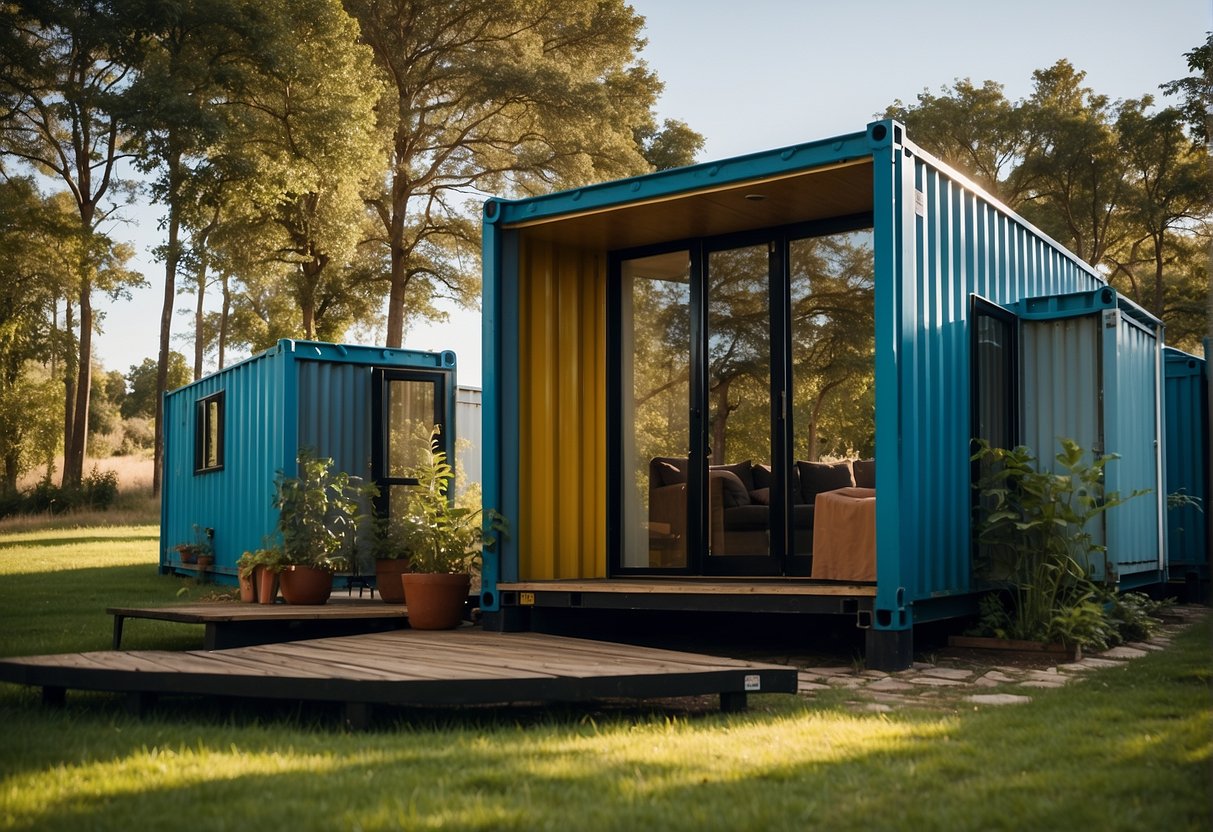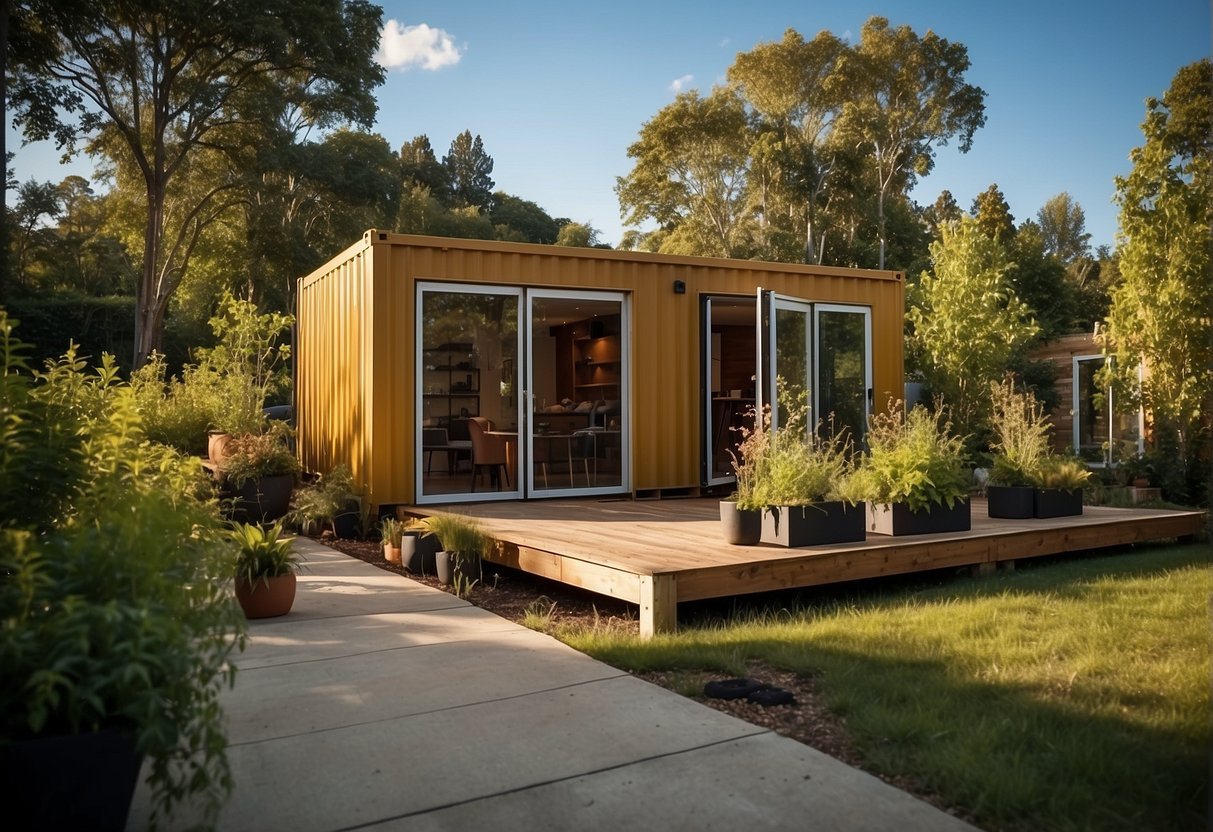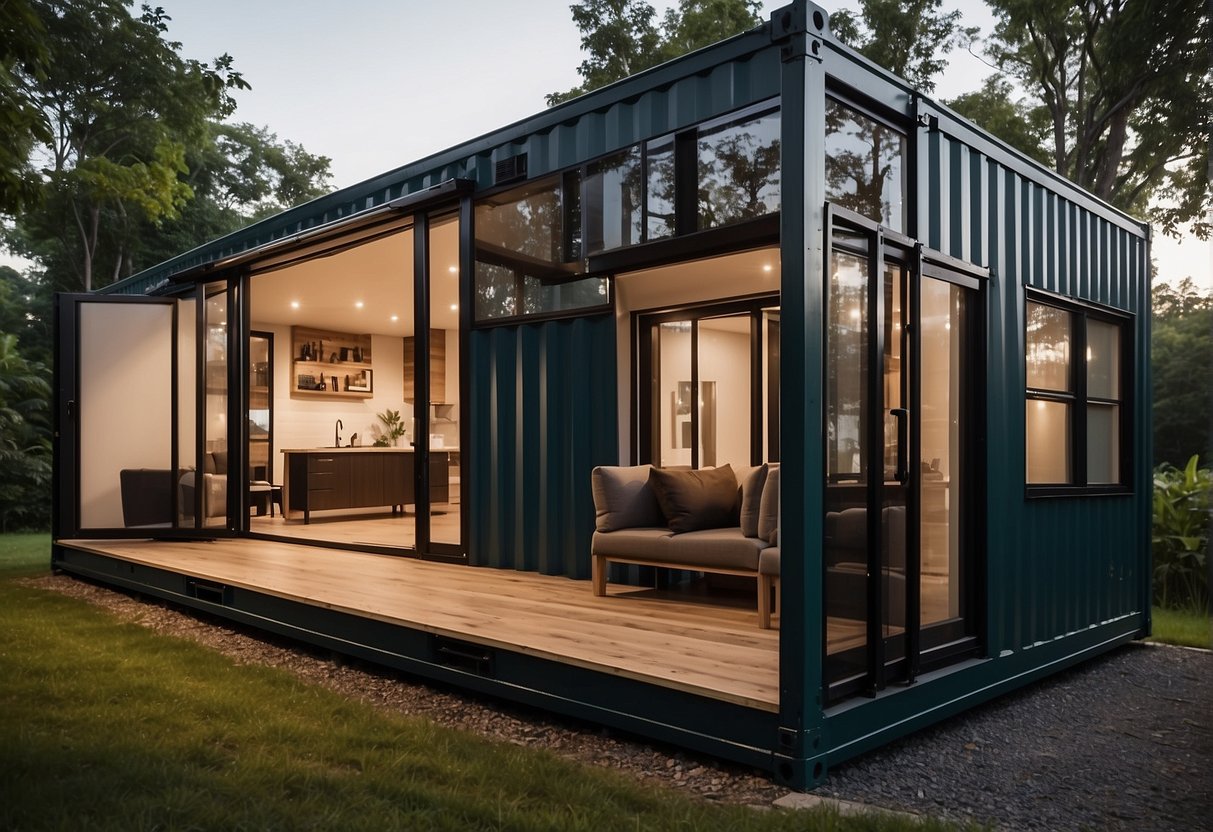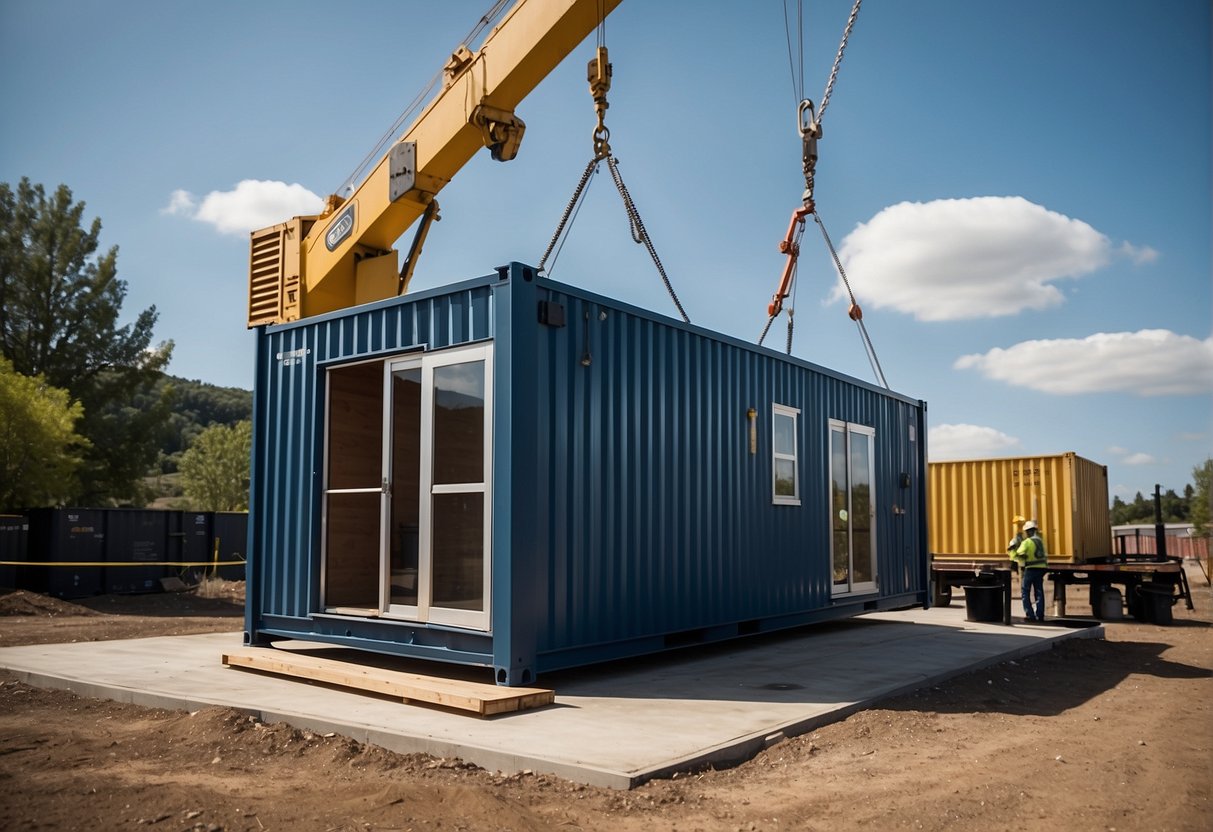Shipping container homes represent a novel approach to residential living, offering both efficiency and flexibility. These homes are crafted from steel shipping containers, which have historically been used for the transportation of goods across the globe.
In recent years, they have gained popularity as a base material for creating affordable housing options. Their robust structure makes them suitable for various climates and conditions, providing a sturdy alternative to traditional building materials.

The adaptability of shipping container homes is one of their most appealing attributes. They can be customized to fit individual tastes and needs, ranging from simple, single-container layouts to more complex, multi-container configurations.
This flexibility allows potential homeowners to design their living spaces according to their unique preferences while often being more affordable than conventional homes.
In addition to their cost-effectiveness, shipping container homes are praised for their eco-friendly qualities. The recycling of containers for housing repurposes these steel structures, reducing the demand on the resources needed for new construction.
This sustainable aspect, combined with the ability to incorporate green technologies such as solar panels and rainwater harvesting systems, positions container homes as an innovative solution in the realm of alternative living spaces.
Types and Sizes
Shipping container homes come primarily in two sizes: the modest 20 feet by 8 feet and the more spacious 40 feet by 8 feet. These dimensions offer a compact living area, with the taller “high cube” versions adding extra vertical space, providing more airiness within the same footprint.
| Type | Size | Area |
|---|---|---|
| Standard | 20′ x 8′ | 160 sq ft |
| Large | 40′ x 8′ | 320 sq ft |
| High Cube | 40′ x 8′ (taller) | 320 sq ft |
Cost and Financing
When considering the purchase of a shipping container home, understanding the intricacies of cost and the available financing options is crucial. These homes can be both cost-effective and efficient, offering a unique investment opportunity for prospective homeowners.
Budgeting for Your Container Home
The initial cost of a single shipping container can range from roughly $2,000 to $8,000, depending on various factors such as quality and location.
For those looking to purchase shipping container homes, it’s essential to budget for both the purchase of the container and the necessary modifications. Costs can escalate quickly with customization, potentially involving architectural design, structural reinforcements, insulation, plumbing, electrical work, and interior finishes.
Prospective buyers should prepare for the total cost, which can start as low as $1,200 for a used 160-square-foot container to upwards of $10,000 or more for larger, new units.
Financing Options and Investment Potential
Financing a shipping container home can be similar to financing traditional homes, with options such as mortgages and construction loans. However, due to their non-traditional nature, some buyers may find it challenging to secure financing through conventional lenders. Alternative financing options may include personal loans, manufacturer financing, or loans specifically for eco-friendly or non-traditional housing.
Investment-wise, shipping container homes have the potential to appreciate in value, much like traditional homes, depending on their construction quality, location, and market demand. Their affordability and eco-friendliness are attractive features that can contribute to their investment potential.
Furthermore, the market for storage container homes is projected to reach $13.48 billion by 2026, indicating a healthy growth rate and investment potential for these unique dwellings.
Lifestyle and Living
Shipping container homes are becoming synonymous with a sustainable lifestyle, offering a small footprint and the chance of living off the grid. These residences, often crafted from recycled steel, provide a unique take on reducing one’s carbon footprint while embracing alternative living spaces.
Day-to-Day Living
In the typical shipping container home, residents enjoy a simplified lifestyle, focusing on functionality and efficiency. Space constraints encourage a minimalist approach to possessions and decor.
Daily life involves strategic organization and the use of multi-functional furniture to ensure the living space remains uncluttered and adaptable to various needs.
Maximizing Space
Living in a compact dwelling necessitates creative space solutions:
- Built-in storage
- Convertible furniture
- Vertical space utilization
These elements are critical for comfort and utility. Incorporating outdoor areas can also expand living spaces, seamlessly blending indoor and outdoor living.
Sustainability and Impact
Shipping container homes exemplify sustainability in several ways:
- Materials: The primary structure comes from recycled steel, significantly lowering the demand for new materials.
- Energy Use: Many shipping container homes are designed to be energy-efficient, often including solar panels and other renewable energy sources to facilitate an off-the-grid lifestyle.
- Environmental Footprint: A small physical footprint means less land disturbance and potential for a reduced carbon footprint, making these homes an eco-conscious choice.
Case Studies and Examples

This section examines real-world applications of shipping container homes, showcasing successful projects and innovative designs that make use of this unique architectural solution.
Successful Container Home Projects
Backcountry Containers designs custom homes that blend aesthetics with functionality. One such project is based in Texas, featuring a rooftop deck.
- THE EZRA 20ft Container Home Starting at $54,000
- THE AUGUSTINE 40ft Hunting Container Cabin Starting at $66,000
- THE KENNEDY 40ft Container Home Starting at $75,000
- THE CLARK Staggered Two 40ft Container Home Starting at $129,000
The Honomobo HO4+ model is a notable example of a modern, fully-functional container home, with living space crafted from four steel shipping containers.
- HO2 2 Bedroom 1 BATH | 640 FT² Starting at $221,605 USD
- HO3 2 Bedroom 2 BATH | 960 FT² Starting at $275,266 USD
- HO4 3 Bedroom 2 BATH | 1280 FT² Starting at $358,669 USD
- HO5 3 Bedroom 2½ BATH | 1600 FT² Starting at $429,839 USD
Bob’s Containers offers a range of container home designs, such as the The PORTER model, which boasts a smart layout and eco-friendly features.
- “THE PORTER” Model 40 FT Luxury Container Home Starting at $141,041
- “THE JOSHUA” Model 40 FT Luxury Container Home Starting at $90,255
- “THE MAGNOLIA” Model 40 FT Luxury Container Home Starting at $119,803
Relevant Buildings in the Oregon provides bespoke solutions where containers become stylish, permanent homes tailored to clients’ specifications.
| MODEL | SQ FT | SHELL | FULLY FINISHED | ON-SITE “ALL-IN” | ||
|---|---|---|---|---|---|---|
| 1 BED
1 BATH |
SADU | 320 | 65,000 | 140,000 | 161,000 | 15,000 |
| STEP 2 | 356 | 52,000 | 121,000 | 143,000 | 12,000 | |
| RAMONA 40 | 442 | 65,000 | 152,000 | 226,000 | INCLUDED | |
| DE LUX 20 | 520 | 79,000 | 149,000 | 256,000 | INCLUDED* | |
| SUITE SPOT 40 | 663 | 98,000 | 211,000 | 258,000 | 25,000 | |
| 2 BED 1 BATH |
TEA HOUSE 20 | 760 | 120,000 | 225,000 | 275,000 | 27,500 |
| 2 BED
2 BATH |
SUITE TEA 20 | 998 | 135,000 | 275,000 | 358,000 | 30,000 |
| DE LUX 40 | 1024 | 110,000 | 227,000 | 398,000 | INCLUDED* | |
| BOX CAR 1 | 1280 | 178,000 | 350,000 | 476,000 | INCLUDED | |
| BOX CAR 2 | 1280 | 182,000 | 355,000 | 482,000 | INCLUDED | |
| 3 BED
2 BATH |
DE LUX 45 | 1443 | 124,000 | 245,000 | 425,000 | INCLUDED* |
| BOX CAR 3 | 1646 | 221,000 | 403,000 | 548,000 | INCLUDED |
Ballance Containers specializes in durable structures that are also affordable, emphasizing the balance between cost and quality in the creation of their container homes.
- The C-800 2 or 3 Bed, 1 Bathroom, 1 Kitchen – Starting from $199,995
- The C-960 2 or 3 bed, 1 Bathroom, 1 Kitchen – Starting from $325,000
- The T-1280 3 or 4 bed, 2 Bathroom, 1 Kitchen – Starting from $450,000
Innovative Designs and Solutions
Kubed Living stands out for its emphasis on eco-friendly and smart home designs, creating spaces that foster both comfort and energy efficiency.
In contrast, Giant Containers takes container home customization to the next level with features that cater to luxurious living without compromising on the environmental ethos of container reuse.
Custom Container Living offers numerous customization options, from minimalist designs to multi-story residences, ensuring that container living can meet a wide range of lifestyle needs.
Meanwhile, MODS International has made headlines with its compact and transportable container homes, capable of being shipped anywhere across the globe.
Integrating creative design with functionality, Container Homes USA builds homes that exemplify the versatility and potential of shipping containers as sustainable building blocks for modern living spaces.
Future Prospects

The shipping container home market is poised for growth, reflected by a projected increase to approximately $13.48 billion by 2026. This expansion can be attributed to the blend of contemporary design offered by modular homes and the drive for innovation in affordable housing solutions nationwide.
Market Trends and Predictions
Shipping container homes are becoming an increasingly attractive option in the real estate market. The demand for these types of homes is expected to see a significant rise due to their affordability, sustainability, and faster construction times compared to traditional housing.
Industry experts predict the market will see a compound annual growth rate of 7.5% leading up to 2026, indicating a robust trend in favor of these homes. Moreover, the transition toward sustainable living and the utilization of upcycled materials have made modular homes constructed from shipping containers trendsetters in the housing sector.
Technological Advancements
The shipping container home industry continues to evolve with technology playing a pivotal role. Innovations such as improved insulation materials, solar panel integration, and smart home technologies are being incorporated into these modular dwellings.
Technological advancements are not only improving the livability of shipping container homes but are also addressing energy efficiency and building code compliance, further establishing them as a viable option for future homeowners nationwide.
Getting Started
Embarking on the journey to owning a shipping container home involves initial research, seeking experienced builders, and absorbing wisdom from seasoned professionals. This section outlines the essential steps to lay the groundwork for a successful project.

How to Begin Your Journey
One’s journey begins with understanding what a shipping container home involves and the variety of design possibilities. Prospective owners should research the basics of container homes, zoning laws, and potential costs. They should also explore different plans to ascertain what aligns with their needs and budget.
Finding a Reputable Builder
Identifying a reputable builder is crucial. One should look for companies specializing in container homes that offer custom builds tailored to individual requirements. It is important to check the builder’s past projects, client testimonials, and their ability to handle necessary permits and codes.
Learning from Experts
Gaining expert advice is invaluable. Interested individuals should seek knowledge from architects and engineers who have experience in container home construction.
They can learn from experts through online forums, workshops, and by perusing resources from established container home builders with a solid track record.
This not only helps in refining their vision but also in anticipating challenges.
